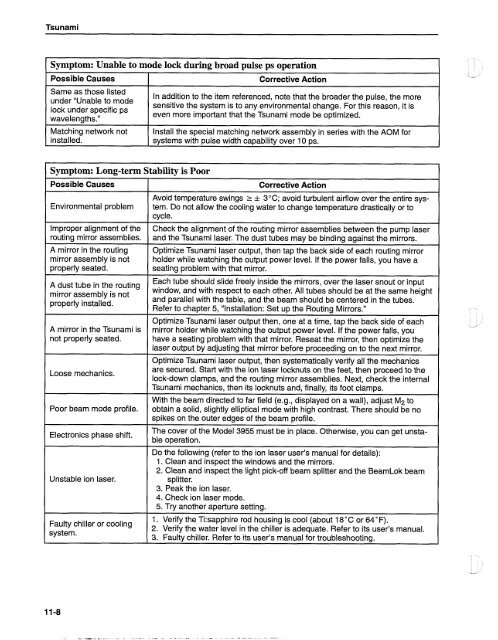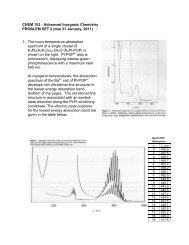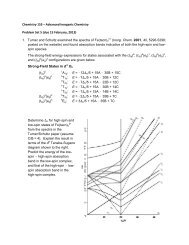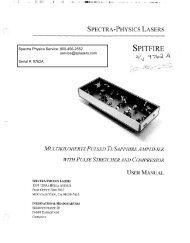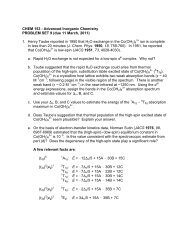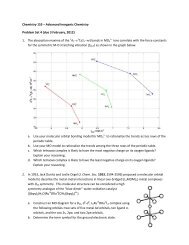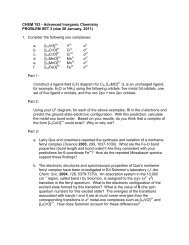Tsunami - Beckman Institute Laser Resource Center
Tsunami - Beckman Institute Laser Resource Center
Tsunami - Beckman Institute Laser Resource Center
You also want an ePaper? Increase the reach of your titles
YUMPU automatically turns print PDFs into web optimized ePapers that Google loves.
<strong>Tsunami</strong><br />
Symptom: Unable to mode lock during broad pulse ps operation<br />
Possible Causes<br />
Corrective Action<br />
Same as those listed<br />
under "Unable to mode<br />
lock under specific ps<br />
wavelengths."<br />
Matching network not<br />
installed.<br />
In addition to the item referenced, note that the broader the pulse, the more<br />
sensitive the system is to any environmental change. For this reason, it is<br />
even more important that the <strong>Tsunami</strong> mode be optimized.<br />
Install the special matching network assembly in series with the AOM for<br />
systems with pulse width capability over 10 ps.<br />
Symptom: Long-term Stability is Poor<br />
Possible Causes<br />
Corrective Action<br />
Avoid temperature swings 1 * 3°C; avoid turbulent airflow over the entire sys-<br />
Environmental problem tem. Do not allow the cooling water to change temperature drastically or to<br />
cycle.<br />
Improper alignment of the<br />
routing mirror assemblies.<br />
A mirror in the routing<br />
mirror assembly is not<br />
properly seated.<br />
A tube in the routing<br />
mirror assembly is not<br />
properly installed.<br />
A mirror in the <strong>Tsunami</strong> is<br />
not properly seated.<br />
Loose mechanics.<br />
Poor beam mode profile.<br />
Electronics phase shift.<br />
Unstable ion laser.<br />
Faulty chiller<br />
system.<br />
Or<br />
Check the alignment of the routing mirror assemblies between the pump laser<br />
and the <strong>Tsunami</strong> laser. The dust tubes may be binding against the mirrors.<br />
Optimize <strong>Tsunami</strong> laser output, then tap the back side of each routing mirror<br />
holder while watching the output power level. If the power falls, you have a<br />
seating problem with that mirror.<br />
Each tube should slide freely inside the mirrors, over the laser snout or input<br />
window, and with respect to each other. All tubes should be at the same height<br />
and parallel with the table, and the beam should be centered in the tubes.<br />
Refer to chapter 5, "Installation: Set up the Routing Mirrors."<br />
Optimize <strong>Tsunami</strong> laser output then, one at a time, tap the back side of each<br />
mirror holder while watching the output power level. If the power falls, you<br />
have a seating problem with that mirror. Reseat the mirror, then optimize the<br />
laser output by adjusting that mirror before proceeding on to the next mirror.<br />
Optimize <strong>Tsunami</strong> laser output, then systematically verify all the mechanics<br />
are secured. Start with the ion laser locknuts on the feet, then proceed to the<br />
lock-down clamps, and the routing mirror assemblies. Next, check the internal<br />
<strong>Tsunami</strong> mechanics, then its locknuts and, finally, its foot clamps.<br />
With the beam directed to far field (e.g., displayed on a wall), adjust Mp to<br />
obtain a solid, slightly elliptical mode with high contrast. There should be no<br />
spikes on the outer edges of the beam profile.<br />
The cover of the Model 3955 must be in place. Otherwise, you can get unstable<br />
operation.<br />
Do the following (refer to the ion laser user's manual for details):<br />
1. Clean and inspect the windows and the mirrors.<br />
2. Clean and inspect the light pick-off beam splitter and the BeamLok beam<br />
splitter.<br />
3. Peak the ion laser.<br />
4. Check ion laser mode.<br />
5. Tw another a~erture settina.<br />
1. Verify the Tisapphire rod housing is cool (about 18°C or 64°F).<br />
2. Verify the water level in the chiller is adequate. Refer to its user's manual.<br />
3. Faultv chiller. Refer to its user's manual for troubleshootina.


